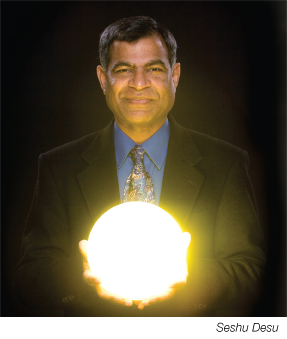
The biggest energy bang for the buck comes from sunlight, and Seshu Desu’s research aims to tap that immense supply of renewable energy and make it easily accessible as a flexible, large-area and low-cost, autonomous power source.
“We’re attacking both sides of the problem: We want an integrated system that can generate power with solar cells and store that power more efficiently and at a lower cost,” said Desu, dean of Binghamton University’s Thomas J. Watson School of Engineering and Applied Science, and the head of a research team tackling how to harness the sun’s energy potential.
“The solar energy we could access in one day could support the electricity needs of the Earth for a year at the present rate of consumption,” Desu added. “By 2015, solar cells as power sources could be a huge industry.”
Desu’s research focuses on creating autonomous power systems based on flexible thin-film solar cells. Although the typical generation efficiency of these solar cells today is about 10 percent, he hopes to increase that efficiency through novel design and restructuring of the cell itself. The developing field of nanotechnology can help achieve this goal.
When materials are structured into much smaller dimensions as nanoparticles, it increases the number of surfaces. This, in turn, increases the capacity to interact with the environment without increasing the size of the basic unit.

Scientists have discovered that materials also have other unexpected and often beneficial properties when their sizes are reduced to nano levels. Desu’s research will take advantage of these as yet unknown properties in constructing the next generation of thin-film solar cells, in which nanoparticles cover a large surface area to maximize generation efficiency, reduce the cost and increase reliability.
The other side of the coin in developing lowercost power sources using solar cells is that the energy that is produced must be stored efficiently and still provide ready, reliable access for several years.
Desu compares marathon runners and sprinters to explain the current state of energy storage devices.
“Batteries are marathoners — they have high energy density but low power density,” he explained. “Capacitors are the opposite because they can supply high levels of power quickly, such as when you turn on your laptop computer.”
The problem with energy-dense batteries is their size and lifetime, whereas lightning-fast capacitors run down quickly. The solution is to combine the best qualities of both into a supercapacitor, Desu said.
“Potential for solar energy utilization can be maximized when the solar cells are integrated with high-efficient energy storage supercapacitor devices that could accommodate the accelerated power needs. We were able to produce supercapacitors with significantly high energy and power densities with extremely long cycle lifetimes using the advantages of nanostructuring as well as thin-film nanocomposite materials,” he said.
“To achieve high-energy density and prevent self-discharge through open circuit reactions, we developed inorganic and organic solid-state electrolytes as gels or membranes with ionic conductors that are biologically derived.” Integrated solar-cell supercapacitor structures as autonomous power sources are also being investigated, Desu added.
Desu holds degrees in mathematics, physics, chemistry, materials science and electrical engineering. His research activity began in industry, then continued at the University of Massachusetts at Amherst and Virginia Tech. He has secured 29 patents and published 235 refereed journal papers, which have led to more than 3,500 citations.
As a professor and a researcher at both universities, Desu brought in more than $10 million in research grants. He was department head at Amherst from January 1999 to August 2006, during which time the department increased its research expenditures from $3.5 million to $8.5 million and won a coveted National Science Foundationfunded Engineering Research Center designation worth $40 million.
A former Amherst colleague, Professor Alok Rastogi, a physicist with 35 years’ experience in solar cells and nanomaterials, has joined Desu at Binghamton University to assist with this research.
The direct applications of the autonomous power system based on solar cells are found everywhere, not just in computers or electronic gadgets, Desu said.
“Research should ultimately transfer scientific innovations into useful products and processes that would benefit society. It’s not just curiosity,” he said.
In addition to flexible, large-area autonomous power sources, there is a growing need for highly efficient large-area lighting. For that latter purpose, some members of his group are developing ZnObased light-emitting diodes (LED), he added.
His group has also been developing flexible thinfilm medical sensing devices. Desu suggests that due to their flexibility and precision detection capacity, these sensing devices could be built into the environment. For example, if built into the walls of a shower stall, the devices would remain unobtrusive yet provide accurate monitoring of potential health threats.
page 1 | page 2